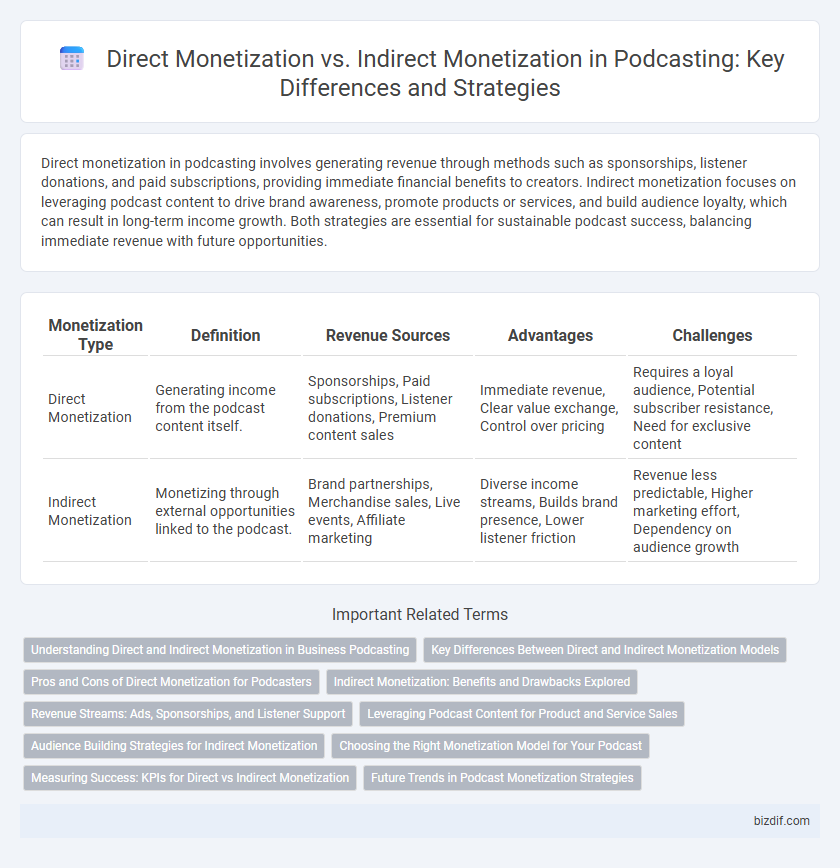Direct monetization in podcasting involves generating revenue through methods such as sponsorships, listener donations, and paid subscriptions, providing immediate financial benefits to creators. Indirect monetization focuses on leveraging podcast content to drive brand awareness, promote products or services, and build audience loyalty, which can result in long-term income growth. Both strategies are essential for sustainable podcast success, balancing immediate revenue with future opportunities.
Table of Comparison
| Monetization Type | Definition | Revenue Sources | Advantages | Challenges |
|---|---|---|---|---|
| Direct Monetization | Generating income from the podcast content itself. | Sponsorships, Paid subscriptions, Listener donations, Premium content sales | Immediate revenue, Clear value exchange, Control over pricing | Requires a loyal audience, Potential subscriber resistance, Need for exclusive content |
| Indirect Monetization | Monetizing through external opportunities linked to the podcast. | Brand partnerships, Merchandise sales, Live events, Affiliate marketing | Diverse income streams, Builds brand presence, Lower listener friction | Revenue less predictable, Higher marketing effort, Dependency on audience growth |
Understanding Direct and Indirect Monetization in Business Podcasting
Direct monetization in business podcasting involves generating revenue through methods such as sponsorship deals, listener subscriptions, and paid advertisements integrated within the podcast content. Indirect monetization leverages the podcast as a marketing tool to drive brand awareness, generate leads, and promote products or services outside the show, enhancing overall business growth. Understanding the balance between direct income streams and indirect promotional benefits is crucial for maximizing the podcast's financial impact.
Key Differences Between Direct and Indirect Monetization Models
Direct monetization in podcasting involves generating revenue through methods such as paid subscriptions, premium content, and listener donations, allowing podcasters to earn income directly from their audience. Indirect monetization relies on external revenue streams like sponsorship deals, advertising, and affiliate marketing, where earnings are derived from third parties based on podcast popularity and listener engagement. Key differences include the source of income--audience versus advertisers--and the level of control podcasters have over pricing and content accessibility.
Pros and Cons of Direct Monetization for Podcasters
Direct monetization in podcasting allows creators to earn revenue through sponsorships, listener donations, and premium content subscriptions, enabling immediate income tied closely to audience engagement. Pros include greater control over revenue streams and fostering a loyal community willing to support content financially without intermediaries. Cons involve potential audience alienation due to ads or paywalls and the challenge of securing consistent sponsorship deals or donations, which may limit growth compared to broader indirect monetization strategies like brand building or merchandise sales.
Indirect Monetization: Benefits and Drawbacks Explored
Indirect monetization in podcasting leverages brand partnerships, merchandise sales, and audience engagement strategies to generate revenue without relying solely on ads or subscriptions. Benefits include building a loyal community and creating diverse income streams that enhance long-term sustainability. Drawbacks involve delayed revenue realization and the need for consistent content quality to maintain audience interest and trust.
Revenue Streams: Ads, Sponsorships, and Listener Support
Revenue streams in podcasting include direct monetization methods such as listener support through Patreon or paid subscriptions, offering creators a steady income from their audience. Indirect monetization relies on ads and sponsorships where brands pay for exposure, leveraging the podcast's reach and niche audience demographics. Combining these strategies maximizes revenue potential while maintaining content quality and listener engagement.
Leveraging Podcast Content for Product and Service Sales
Direct monetization of podcasts involves generating revenue through sponsorships, advertisements, and listener subscriptions, providing immediate income streams. Indirect monetization leverages podcast content to drive product and service sales by building brand authority, engaging audiences, and creating trust that converts listeners into customers. Utilizing targeted calls-to-action within episodes and offering exclusive promotions can effectively translate podcast engagement into tangible business growth.
Audience Building Strategies for Indirect Monetization
Audience building strategies for indirect monetization in podcasting emphasize creating valuable content that fosters listener loyalty and engagement, which attracts sponsorships and merchandise opportunities. Leveraging social media platforms and email newsletters expands reach and deepens connections, increasing brand awareness and listener retention. Building a strong community around the podcast encourages word-of-mouth promotion and opens avenues for indirect revenue streams such as affiliate marketing and premium memberships.
Choosing the Right Monetization Model for Your Podcast
Choosing the right monetization model for your podcast depends on your audience size, content niche, and long-term goals. Direct monetization methods like sponsorships and listener donations provide immediate revenue but require a loyal and engaged listener base. Indirect monetization, including merchandise sales and promoting affiliate products, builds brand value and passive income streams while fostering deeper audience relationships.
Measuring Success: KPIs for Direct vs Indirect Monetization
KPIs for direct monetization in podcasting include revenue per episode, number of paid subscriptions, and advertising income, providing clear financial metrics for success. Indirect monetization KPIs focus on audience engagement metrics such as listener growth, social media shares, and brand partnerships, reflecting broader influence and content reach. Tracking these distinct KPIs helps podcasters optimize strategies for both immediate income and long-term brand value.
Future Trends in Podcast Monetization Strategies
Future trends in podcast monetization strategies indicate a significant shift towards combining direct monetization methods, such as subscription models and exclusive content, with indirect approaches like brand partnerships and targeted advertising. Advancements in AI-driven analytics will enable podcasters to optimize listener engagement and tailor monetization tactics more effectively, maximizing revenue streams. Emerging blockchain technologies are also poised to enhance transparency and microtransaction capabilities, fostering innovative revenue models within the podcasting industry.
Direct monetization vs Indirect monetization Infographic

 bizdif.com
bizdif.com